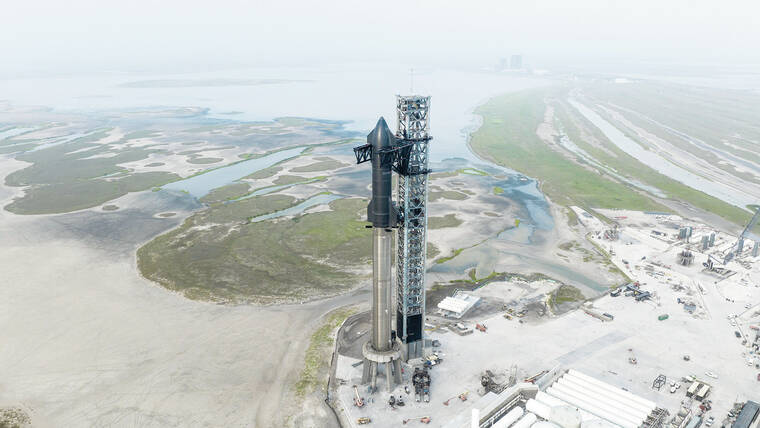LIHU‘E — The most powerful rocket ever built could splash down off the coast of Kaua‘i within the next two weeks, according to Elon Musk’s Twitter account.
The SpaceX CEO tweeted Monday that the company’s massive Starship rocket will conduct it’s first orbital launch “near the end of third week of April,” pending final regulatory approval.
According to documents filed with the Federal Communications Commission, the flight will launch from Starbase, Texas, and achieve orbit before conducting a “soft ocean landing” about 62 miles off the northwest coast of Kaua‘i.
The U.S. Coast Guard put local mariners on notice about the projected splashdown earlier this month.
“We put out a broadcast to mariners issuing a safety zone, warning them that it’s going to be landing in this specific area, and to be aware and make sure you’re not in the vicinity to avoid any accidents,” U.S. Coast Guard spokesperson Petty Officer Ryan Fisher told The Garden Island on Monday, April 10, 2023.
Fisher reported that the Coast Guard had been in communication with SpaceX, but did not have a clear timeline of when the launch would occur.
The rocket is currently stacked at the Starbase facility and is ready to launch, but awaits final regulatory approval from the Federal Aviation Agency. The FAA issued a notice Monday that the launch could occur on April 17, though this date is not set in stone.
Powered by 33 engines using sub-cooled liquid methane and liquid oxygen, the Starship will dwarf the thrust capacity of NASA’s Space Launch System, which previously held the title for world’s most powerful rocket. The Starship is also the largest rocket ever constructed, standing at a startling 394 feet tall.
For scale, that is almost 100 feet taller than the Statue of Liberty, and would compete with the tallest skyscrapers in the Honolulu skyline.
SpaceX touts the rocket as fully reusable, and capable of carrying crew and cargo to Earth orbit, the Moon and Mars. They also claim that it is capable of “point-to-point transport on Earth, enabling travel to anywhere in the world in one hour or less.”
Since the rocket is reusable, Kaua‘i Surfrider Foundation Chair Gordon LaBedz said he was not particularly concerned about the environmental impact of the landing, comparing it favorably to U.S. Navy Pacific Missile Range Facility weapons tests.
“I don’t see it as a big environmental disaster — it’s just a one-shot deal, they’re going to pick it up, it’s not going to stick around in the ocean,” said LaBedz. “I just sure hope it doesn’t hit Princeville.”
A successful landing is far from a certainty, with four previous Starship high-altitude test flights ending in fiery explosions. The fifth time proved to be the charm for the Starship, when the prototype was finally able to successfully launch and land in May 2021 (though it did spark a small fire at the landing site).
Musk has previously estimated the current Starship rocket has only a 50 percent chance of successfully reaching orbit.
The Navy at the Pacific Missile Range Facility said Monday that it would assist SpaceX in collecting data on the landing through “telemetry, optics and radar,” which will inform future Starship designs and models. The entire flight is expected to take about an hour and a half, with the booster section of the rocket separating and landing in the Gulf of Mexico within the first few minutes.
Though SpaceX is a privately owned company, their efforts are largely taxpayer-funded, with the business receiving billions of dollars in contracts from the federal government.
•••
Guthrie Scrimgeour, reporter, can be reached at 808-647-0329 or gscrimgeour@thegardenisland.com.






Wouldn’t it be ironic and strangely fitting if it landed on Zuckerberg’s place?